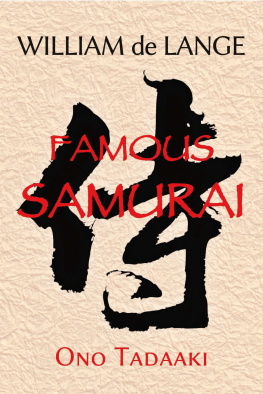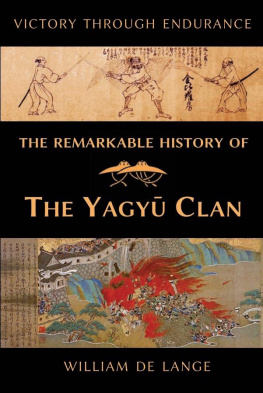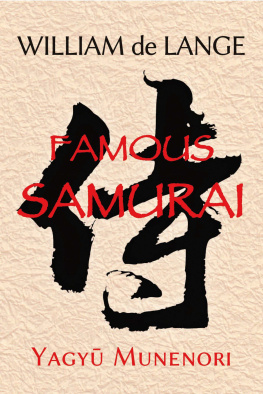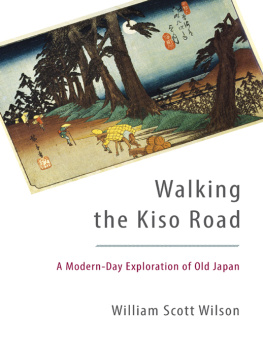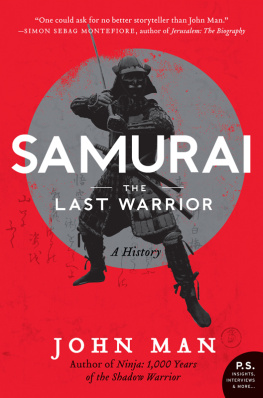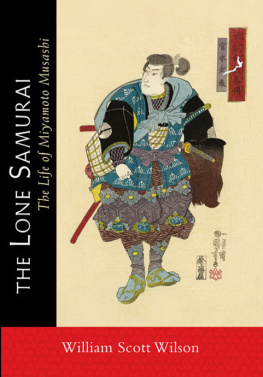William de Lange - Famous Samurai: Ono Tadaaki
Here you can read online William de Lange - Famous Samurai: Ono Tadaaki full text of the book (entire story) in english for free. Download pdf and epub, get meaning, cover and reviews about this ebook. year: 2008, publisher: Floating World Eds., genre: Detective and thriller. Description of the work, (preface) as well as reviews are available. Best literature library LitArk.com created for fans of good reading and offers a wide selection of genres:
Romance novel
Science fiction
Adventure
Detective
Science
History
Home and family
Prose
Art
Politics
Computer
Non-fiction
Religion
Business
Children
Humor
Choose a favorite category and find really read worthwhile books. Enjoy immersion in the world of imagination, feel the emotions of the characters or learn something new for yourself, make an fascinating discovery.
- Book:Famous Samurai: Ono Tadaaki
- Author:
- Publisher:Floating World Eds.
- Genre:
- Year:2008
- Rating:4 / 5
- Favourites:Add to favourites
- Your mark:
- 80
- 1
- 2
- 3
- 4
- 5
Famous Samurai: Ono Tadaaki: summary, description and annotation
We offer to read an annotation, description, summary or preface (depends on what the author of the book "Famous Samurai: Ono Tadaaki" wrote himself). If you haven't found the necessary information about the book — write in the comments, we will try to find it.
Famous Samurai: Ono Tadaaki — read online for free the complete book (whole text) full work
Below is the text of the book, divided by pages. System saving the place of the last page read, allows you to conveniently read the book "Famous Samurai: Ono Tadaaki" online for free, without having to search again every time where you left off. Put a bookmark, and you can go to the page where you finished reading at any time.
Font size:
Interval:
Bookmark:

Ono Tadaaki

FLOATING WORLD EDITIONS
Published by Floating World Editions, Inc.
26 Jack Corner Road, Warren, CT 06777
www.oatingworldeditions.com
Floating World Editions publishes books that contribute to a deeper understanding of Asian cultures. Editorial supervision: Ray Furse.
Previously published in:
Famous Japanese Swordsmen: The Period of Unification
Copyright 2008 by William de Lange.
First print edition, copyright 2008
First digital edition, copyright 2012
Protected by copyright under the terms of the International Copyright Union; all rights reserved. Except for fair use in book reviews, no part of this book may be reproduced for any reason by any means, including any method of digital reproduction, without the permission of the publisher.
ISBN 978-1-891640-68-1
Iaid
Through the Eye of the Needle
A History of Japanese Journalism
A Dictionary of Japanese Idioms
A Dictionary of Japanese Proverbs
The Real Musashi, Origins of a Legend I: The Bush denraiki
The Real Musashi, Origins of a Legend II: The Bukden
Miyamoto Musashi: A Life in Arms
Ono Jiremon Tadaaki was born in 1564 as Mikogami Tenzen. His place of birth was Isumi, a small hamlet on the Pacic coast of the Bs Peninsula. Tenzen was born toward the end of the Warring States period, when the Kant was dominated by three powerful warrior clansthe Hj, the Uesugi, and the Takeda. The Bs Peninsula, however, fell under the inuence of another clan, the indomitable Satomi.
The Satomi clan originally hailed from the eponymous village on the western border of the province of Kzuke, where they were founded by Satomi Yoshitoshi, a scion of the powerful house of Nitta.
Tenzens clan, however, was lieged to the house of Toki, a Mino clan, which had risen to the fore at the turn of the fteenth century, when they helped the Satomi subdue the central regions of the Bs Peninsula. Their power base was Mangi castle, a formidable stronghold situated along the Isumi River some ten miles north of Katsura. The Mikogami had received a plot of land along the Isumi River and served the Toki dutifully.
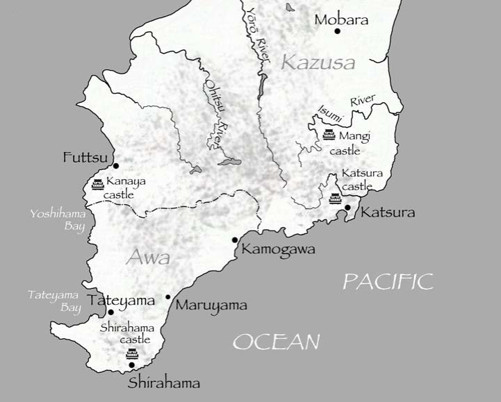
Like his father, Tosa, and his fathers ancestors Tenzen was trained in the martial traditions of his clan from a very young age. Already at the age of ten it became clear that in his natural ability with the sword, the young boy surpassed all the other clan members.
The Mikami-ry, the school of fencing practiced by his clan, did not belong to any of the major schools. But wherever it may have fallen short in its technical aspects, it was amply made up for by the young Tenzens premature insight into his opponents movements. Tenzen displayed an extraordinary ability to adapt old and rusted techniques to ght himself out of situations for which they had never been intended. Such was his astonishing progress that already by the time he was fteen he began to engage in tary shiai , the popular contests with protagonists of other schools of fencing, and in Tenzens day and age there was ample opportunity for such encounters.

The young Mikogami Tenzen
The Warring States period was now at its zenith. There was not a province untouched by internal strife, hardly a corner of Japan that was not mobilized, and not a town that was not awash with soldiers. As they passed through villages and hamlets on their way from one scene of battle to the other, the troops put an immense burden on the hapless populace, who had to feed and of keep the soldiers with the little means they had.
Then there were the large bands of heavily armed bandits, many of them disaffected samurai or ashigaru who had gone without payment for too long. Capitalizing on the general state of lawlessness, they pillaged and raped their way through a society that was already deeply scarred by the ravishes of internecine warfare.
It took men of some resolve, then, to venture outside the relative safety of their lords domain, and even more so engage on a journey in active pursuit of someone with whom to engage in a duel. It seemed that Tenzen belonged to this group of brave men. By the time he had reached the age of seventeen, he had already dueled with most of the swordsmen of note on the Bs Peninsula.
Among the swordsmen with whom Tenzen practiced and dueled, some had been on musha shugy and traveled down south. To the Izu peninsula for instance, where they had come into contact with practitioners of the Tamiya-ry. Or farther still, to the distant island of Kyshu, the home of the exotic Sekiguchi and Shigen-ry. Most, however, had learned their skills closer to home, at the famous Katori and Kashima shrines in the villages of Sawara and Kashima, the birthplaces of the Katori and Kashima Shint schools of fencing.
Bs warriors were good swordsmen, but their skills paled in signicance when compared to the kind of fencing practiced by any of the big names of the time. Men such as Ogasawara Nagaharu, for instance, an exponent of the great Kamiizumi Nobutsunas Shinkage-ry. Men such as Okuyama Kygasai Kimishige, who had also studied fencing under Nobutsuna, but was known for his Okuyama style of fencing. Or the fearsome Sait Denkib Katsuhide, a disciple of Tsukahara Bokuden and founder of the Ten-ry.
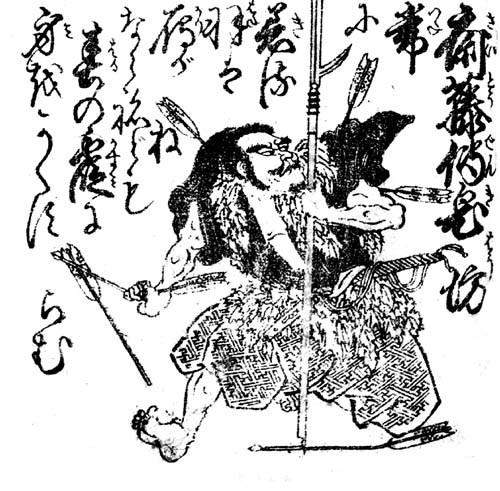
Sait Denkib, desciple of Tsukahara Bokuden and founder of the Ten-ry
Like their former masters, these illustrious swordsmen traveled the length and breadth of the country on their musha shugy , seeking to deepen their understanding of their craft through meditation and honing it in contests with men of their own standing. Thus far Tenzen had not had the opportunity to engage with swordsmen of such repute. He would have to wait another decade before that opportunity would present itself.
The world in which Tenzen grew up was one of constant strife and turmoil. Already during the early fifties, the powerful Hj had invaded the Bs Peninsula. Yet they had failed to take Kururi castle, the headquarters of their overlord, Satomi Yoshitaka. For ten years Yoshitaka had managed to hold on to the castle and keep the enemy at bay. During the sixties the Hj had launched another campaign to capture the Bs Peninsula. Again they had penetrated deep into the peninsula, right up to the borders of the Satomi domains.
To guard their newly acquired territories, they built a fortress on the slopes of Mount Mifune, just south of Kimitsu, a small port on the peninsulas west coast. At one stage they even captured Kururi castle, but by 1567 the Satomi had recovered and driven their foes back toward Mifune. There, on a desolate plain in the shade of the fortress the two forces engaged in a battle for supremacy.
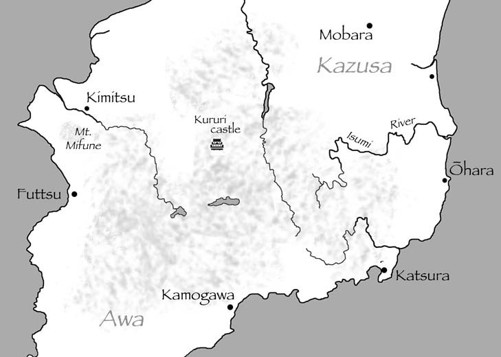
Font size:
Interval:
Bookmark:
Similar books «Famous Samurai: Ono Tadaaki»
Look at similar books to Famous Samurai: Ono Tadaaki. We have selected literature similar in name and meaning in the hope of providing readers with more options to find new, interesting, not yet read works.
Discussion, reviews of the book Famous Samurai: Ono Tadaaki and just readers' own opinions. Leave your comments, write what you think about the work, its meaning or the main characters. Specify what exactly you liked and what you didn't like, and why you think so.

